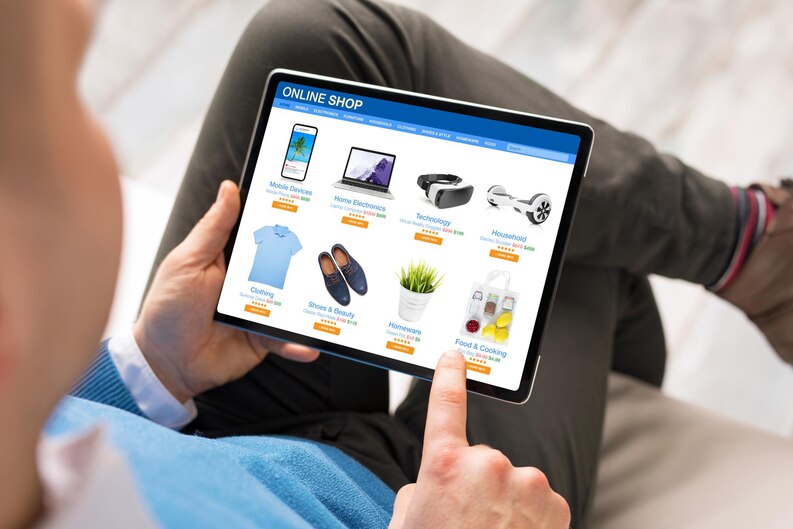In this era of digital enchantment, e-commerce emerges as a wondrous conduit, whisking us away to a realm of boundless convenience. With a mere click, we traverse virtual aisles, indulging in the delights of retail from the cozy confines of our homes. But for businesses daring to embark upon this online odyssey, the creation of an extraordinary e-commerce website becomes an elemental quest. To conquer this quest, one must grasp the essence of the customer, for their desires hold the key to triumph. Embark with me, dear reader, on a journey of exploration as we unveil the crucial aspects that kindle the flames of fascination within the hearts of these discerning patrons. Step into the digital wonderland of e-commerce, where shopping dreams come true at the tap of a button! In this age of online retail magic, businesses must conjure exceptional e-commerce websites to captivate their customers. Picture this: a virtual shopping spree that feels tailor-made just for you. TIPS FOR CREATING A USER-FRIENDLY ECOMMERCE WEBSITE
- User-friendly design: A well-designed website is essential to provide a seamless and intuitive user experience. Implement a clear and straightforward navigation menu that leads customers to their desired products quickly. For instance, the Sephora website features a simple and sleek design that’s easy to navigate, with clear product categories and a user-friendly search function.
- Product presentation: Providing high-quality product images and comprehensive descriptions is crucial to help customers make informed purchasing decisions. For example, the Apple website showcases detailed product descriptions and multiple high-quality images that can be zoomed in for a closer look.
- Streamlined checkout: A streamlined checkout process can reduce cart abandonment rates and enhance customer satisfaction. Offer a guest checkout option and provide a progress indicator to guide customers through the steps. The Amazon website simplifies the checkout process by allowing customers to complete their purchase with just one click.
- Personalization: Personalized product recommendations based on customers’ browsing behavior can significantly enhance their shopping experience. For instance, the Netflix website recommends movies and TV shows based on the customer’s viewing history and preferences.
- Customer reviews and ratings: Displaying honest reviews and ratings can build trust and credibility with potential buyers. For example, the Yelp website provides customer reviews and ratings for restaurants, bars, and other businesses, allowing customers to make informed decisions before making a purchase.
- Responsive customer support: Offering responsive customer support channels can enhance customer satisfaction and build long-term relationships. For example, the Zappos website provides excellent customer support via live chat, phone, and email, ensuring that customers’ inquiries and complaints are promptly addressed.
- Mobile-friendly design: Optimizing your website for mobile devices can help you reach a wider audience. Implement a responsive design that adapts seamlessly to different screen sizes, ensuring a consistent and enjoyable shopping experience for mobile users. The Adidas website features a mobile-friendly design that allows customers to browse and purchase products from their smartphones easily.
- Transparent policies: Clearly communicating shipping costs, delivery times, and return policies can avoid any ambiguity and build trust with customers. For example, the ASOS website offers a clear and straightforward return policy, allowing customers to return their purchases hassle-free.
- Security and trust: Providing a secure shopping environment is essential to inspire customer confidence. Implement robust security measures, such as SSL encryption, and display trust badges and secure payment logos to assure customers of the website’s credibility. For instance, the PayPal website provides a secure and trustworthy payment gateway for online transactions.
Conclusion: In conclusion, if you want to flourish in today’s digital world, you need to have a solid e-commerce website. Businesses may provide customers with a pleasant and stress-free buying experience by making their needs the top priority throughout the whole design and development process. Every element plays an important role in establishing credibility with clients, from user-friendly UX design to streamlined site performance, clear product presentation to tailored suggestions to attentive customer care to open policies and strong security measures. Keeping these factors in mind will help any company build a first-rate e-commerce website that not only satisfies but also delights its target audience. FAQs on Website Design
- What is the importance of responsive design in an e-commerce website?
Responsive design is essential for an e-commerce website because it ensures that the website adapts seamlessly to different screen sizes and devices, such as desktops, tablets, and smartphones. With the increasing use of mobile devices for online shopping, having a responsive design is crucial to provide a consistent and enjoyable user experience. It helps to retain customers, reduce bounce rates, and increase conversions by making it easier for users to navigate, view products, and complete purchases on any device.
- How can I optimize the loading speed of my e-commerce website?
Optimizing the loading speed of your e-commerce website is crucial for a positive user experience. Here are a few ways to improve loading speed:
- Compress and optimize images: Use image compression techniques to reduce file sizes without sacrificing quality. Several online tools and plugins are available to help with image optimization.
- Minimize HTTP requests: Reduce the number of elements (such as scripts, stylesheets, and images) that require separate HTTP requests, as each request adds to the loading time.
- Enable caching: Implement browser caching to store static files locally on users’ devices, reducing the need to fetch them from the server for subsequent visits.
- Minify CSS and JavaScript: Remove unnecessary spaces, line breaks, and comments from your code to reduce file sizes and improve loading speed.
- Use a content delivery network (CDN): A CDN stores copies of your website’s static files on servers worldwide, allowing users to access them from the nearest server, reducing latency and improving loading speed.
- How can I ensure the security of my e-commerce website?
Ensuring the security of your e-commerce website is crucial to protect customer data and inspire trust. Here are some security measures to implement:
- Use SSL encryption: Secure Sockets Layer (SSL) encryption establishes an encrypted connection between the website and the user’s browser, ensuring that sensitive information, such as credit card details, is transmitted securely.
- Regularly update software: Keep your website’s CMS (content management system), plugins, themes, and other software up to date with the latest security patches to address vulnerabilities.
- Implement strong passwords: Enforce strong password policies for user accounts and administrator access. Encourage users to choose unique, complex passwords and enable multi-factor authentication for added security.
- Monitor for suspicious activity: Regularly monitor your website for any suspicious activity or unauthorized access attempts. Implement intrusion detection systems and security plugins to detect and prevent potential threats.
- Secure payment gateways: Use reputable and secure payment gateways that comply with industry security standards, such as Payment Card Industry Data Security Standard (PCI DSS).
- How can I make my e-commerce website stand out visually?
To make your e-commerce website visually appealing and stand out from competitors, consider the following:
- Use high-quality images: Invest in professional product photography to showcase your products in the best possible way. High-resolution, visually engaging images can attract customers and increase their interest in your offerings.
- Maintain a consistent branding: Develop a strong visual identity and maintain consistency across your website. Use consistent color schemes, typography, and imagery that align with your brand’s personality and values.
- Implement a clean and modern design: Opt for a clean and modern design that is visually pleasing and easy to navigate. Use whitespace effectively, organize content logically, and make important elements stand out.
- Focus on typography: Choose fonts that are legible and visually appealing. Use typography to create hierarchy and emphasize important information. Experiment with font sizes, weights, and styles to create a visually engaging experience.
- Incorporate visual elements: Integrate visual elements such as icons, illustrations, and animations to enhance the overall visual appeal and add personality to your website.

